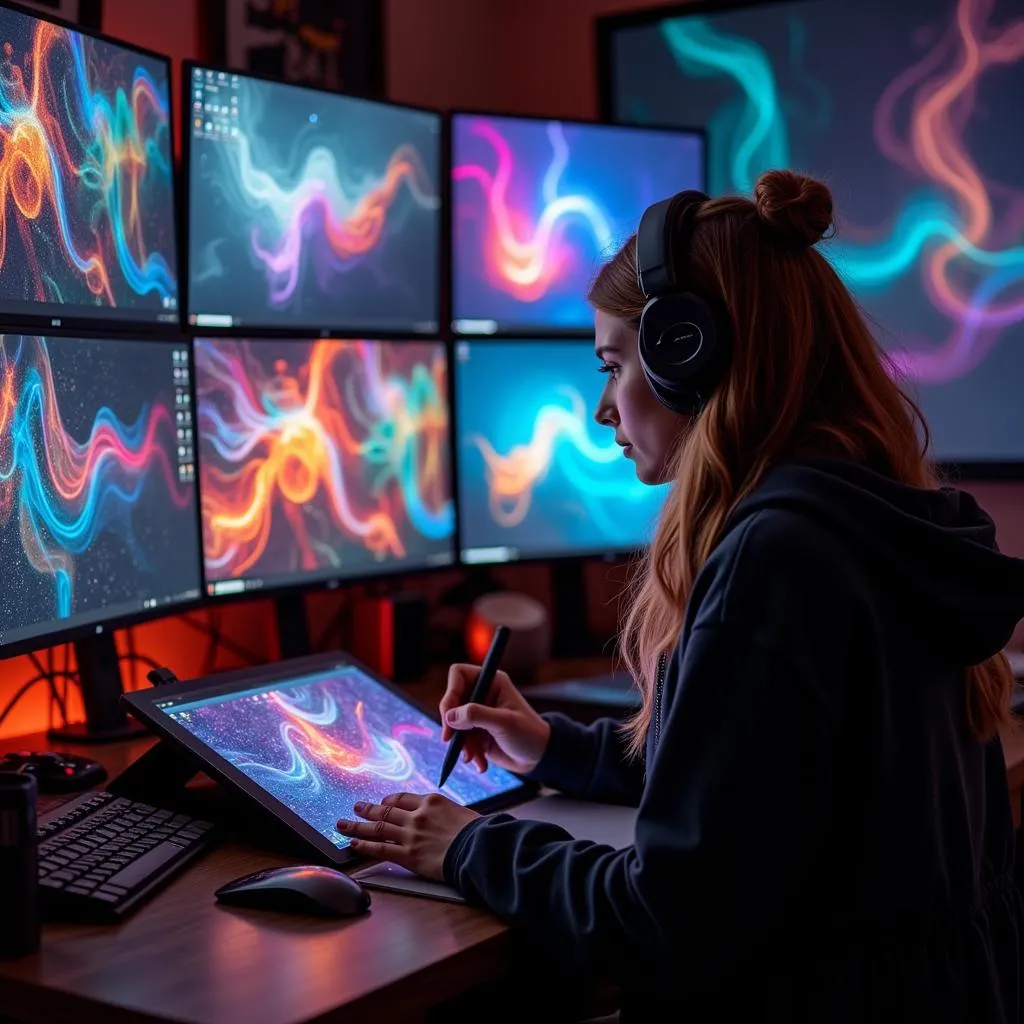Exploring the Depths: Lake Topography Art
Lake Topography Art unveils the hidden world beneath the serene surface of our waters. It’s a fascinating intersection of science, nature, and artistic expression, allowing us to visualize the dramatic contours and intricate details of lakebeds in stunning visual forms. From detailed bathymetric maps transformed into mesmerizing works of art to 3D printed sculptures capturing the underwater landscape, lake topography art offers a unique perspective on these vital ecosystems.
Unveiling the Secrets with Lake Topography Art
What is lake topography art, and why should we care? It’s more than just pretty pictures; it’s a way to connect with the natural world on a deeper level. By representing the underwater terrain, we gain a new understanding of the lake’s ecosystem, history, and the impact of human activity. This art form can be created through various techniques, from traditional painting and drawing to digital art, 3D modeling, and even augmented reality experiences. Each medium brings its own unique flavor to the interpretation of bathymetric data, creating a diverse and captivating field of artistic exploration.
Have you ever wondered what lies beneath the shimmering surface of your favorite lake? Lake topography art allows us to explore that hidden world, revealing the valleys, ridges, and plains that shape the lakebed. This art form not only captivates the eye but also provides valuable insights into the lake’s ecological health and the forces that have shaped its form over time.
Different Techniques in Lake Topography Art: From Traditional to Cutting-Edge
Artists working with lake topography employ a diverse range of techniques to bring their vision to life. Traditional methods like painting and drawing can capture the essence of the underwater landscape with evocative brushstrokes and intricate linework. Meanwhile, digital art and 3D modeling allow for precise representations and the creation of interactive experiences.
One particularly exciting development is the use of 3D printing to create tangible representations of lakebeds. These sculptures allow us to quite literally hold the underwater world in our hands, offering a tactile and immersive experience that traditional art forms cannot replicate.
What are some of the most common techniques used? Artists utilize everything from traditional pen and ink drawings to sophisticated software like GIS and CAD to create these unique artworks. The choice of technique often depends on the desired level of detail, the artistic vision, and the intended use of the final piece.
Lake Topography Art: More Than Just Aesthetics
Beyond its aesthetic appeal, lake topography art plays a crucial role in scientific research, education, and conservation efforts. By visualizing bathymetric data, scientists can gain a deeper understanding of lake ecosystems, identify areas of ecological importance, and track changes over time. This information is vital for developing effective conservation strategies and ensuring the long-term health of our lakes.
How can lake topography art contribute to conservation? By visually representing the impacts of human activities on lake ecosystems, these artworks can raise awareness and inspire action to protect these valuable resources. For example, a piece showcasing sedimentation buildup in a lake can highlight the negative effects of erosion and runoff, prompting communities to adopt more sustainable land management practices.
Furthermore, lake topography art serves as a powerful educational tool, making complex scientific data accessible and engaging for the public. By transforming data into visually appealing and easily understandable forms, this art form can spark curiosity and foster a deeper appreciation for the natural world.
 Digital Art Visualization of Lake Topography for Ecological Studies
Digital Art Visualization of Lake Topography for Ecological Studies
Conclusion: Diving Deeper into Lake Topography Art
Lake topography art offers a unique and compelling perspective on the hidden world beneath the surface of our lakes. From scientific research and education to conservation efforts and pure artistic expression, this burgeoning field has the power to connect us with the natural world in profound ways. By exploring the depths through the lens of art, we gain a deeper appreciation for the intricate beauty and ecological importance of these vital ecosystems.
FAQ
- What is lake topography art? Lake topography art uses bathymetric data to create visual representations of the lakebed.
- How is lake topography art created? It can be created using various methods, from traditional painting and drawing to 3D printing and digital art.
- Why is lake topography art important? It helps us understand lake ecosystems, aids in scientific research, and promotes conservation.
- How can I learn more about lake topography art? Explore online resources, visit art galleries, and connect with artists working in this field.
- Where can I find examples of lake topography art? Online galleries, museums, and scientific publications often feature examples of this art form.
- Can I commission a piece of lake topography art? Yes, many artists specialize in creating custom pieces based on specific lake data.
- What is the future of lake topography art? With advancements in technology, we can expect even more immersive and interactive experiences in the future.
Suggested Topics
- Bathymetric Mapping Techniques
- Underwater Photography and Videography
- The Impact of Climate Change on Lake Ecosystems
- The History of Lake Exploration
Need further assistance? Contact us 24/7: Phone: 02462573573, Email: danteum@gmail.com or visit us at Savico Megamall, 7-9 Đ. Nguyễn Văn Linh, Gia Thụy, Long Biên, Hà Nội 10000, Việt Nam.



